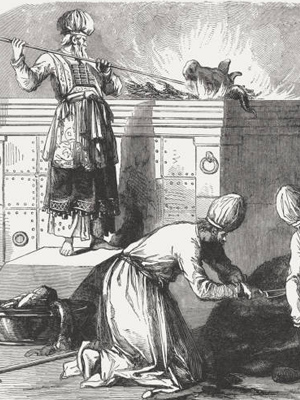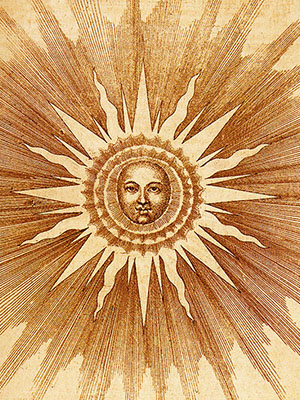Masonic Articles and Essays
The Fire Upon The Altar
Manly P. Hall
Date Published:
9/27/2023
Taken from his short but powerful book Initiates of the Flame, Manly P. Hall decribes the spiritual source of all man's religious impulses throughout the ages. What has driven man to construct his altars, to offer his sacrifices? The flickering flame that rests so fragilely upon the altar.
 As far back as our history goes we find that fire has played an important part in the religious ceremonial of the human race. In practically every religion we find the sacred altar fires, which were guarded by the priests and vestals with greater care than their own lives. In the Bible we find many references made to the sacred fires which were used as one form of devotion by the ancient Israelites. The Altar of Burnt Offerings is as old as the human race, and dates from the time when the first man, lifting himself out of the mists of ancient Lemuria, first saw the sun, the great Fire Spirit of the universe. Among the followers of Zoroaster, the Persian Initiate, fire has been used for centuries in honor of the great Fire God, Ormuzd, who is said by them to have created the universe.
As far back as our history goes we find that fire has played an important part in the religious ceremonial of the human race. In practically every religion we find the sacred altar fires, which were guarded by the priests and vestals with greater care than their own lives. In the Bible we find many references made to the sacred fires which were used as one form of devotion by the ancient Israelites. The Altar of Burnt Offerings is as old as the human race, and dates from the time when the first man, lifting himself out of the mists of ancient Lemuria, first saw the sun, the great Fire Spirit of the universe. Among the followers of Zoroaster, the Persian Initiate, fire has been used for centuries in honor of the great Fire God, Ormuzd, who is said by them to have created the universe.
There are two paths or divisions of humanity whose history is closely related to that of the Wisdom Teachings. They embody the doctrines of fire and water, the two opposites of nature. Those who follow the path of faith or the heart, use water, and are known as the Sons of Seth, while those who follow the path of the mind and action are the Children of Cain, who was the son of Samael, the Spirit of Fire. Today we find the latter among the alchemists, the hermetic philosophers, the Rosicrucians, and the Freemasons.
It is well for us to understand that we ourselves are the cube altar upon which and in which burns the altar fire. For many centuries the Initiate of fire has been nourishing and guarding the Spiritual Flame within himself, as the ancient priests watched day and night the altar fires of Vesta’s temple.
The ever burning lamp of the alchemist, which having burned thousands of years without fuel in the catacombs of Rome, is but a symbol of this same spiritual fire within himself. In the picture we see the ever burning lamp which was carried by the Initiate in his wandering. It represents the spinal column of man, at the top of which is flickering a little blue and red flame. As the lamp of the ancients was fed and kept burning by the purest of olive oil, so man is transmitting within himself and cleansing in the laver of purification the life essences, which, when turned upward, provide fuel for the ever burning lamp within himself.
Upon the altars of the ancients were offered sacrifices to their gods. The ancient Hierophant offered up sacrifices of spices and incense. The Masonic brother of today still has among his symbols the incense burner or censer, but few of the brothers recognize themselves in this symbol. The ancients symbolized under such things as this the development of the individual, and as the tiny spark burning among the incense cubes slowly consumes all, so the Spiritual Flame within the student is slowly burning away and transmuting the base metals and properties within himself, and offering up the essence thereof as the smoke upon the altar of Divinity. It is said that King Solomon, when he completed his temple, offered bulls as a sacrifice to the Lord, by burning them upon the temple altar. Those who believe in a harmless life wonder why so many references are made in the Bible to animal sacrifice.
The student realizes that the animal sacrifices are those of the celestial zodiac, and that when the Ram or the Bull was offered upon the altar, it represented the qualities in man which come through Aries, the celestial Ram, and Taurus, the Bull in the zodiac. In other words, the Initiate, passing through his tests and purification, is offering upon the altar of his own higher being the lower animal instincts and desires within himself. Among the Masonic brothers we also find what is called the Symbol of Mortality. It is a spade, a coffin, and an open grave, while upon the coffin has been laid a sprig of acacia, or evergreen. In the picture we see the spade of the grave digger, which has been considered the symbol of death for centuries.
In the Book of Thoth, that strange document which has descended to man at his present stage of evolution as a deck of playing cards, we find a very wonderful symbolism. Of all the suits of cards, that of the spade is the only suit in which all the court cards face away from the pip. In all the other kings and queens, the faces are looking at the little marker in the corner of the card, but in the spade suit, they look away from it. Now it is said that the spade has been taken from the acorn, but the occult student has a different idea. He sees in the spade, which has for ages been the symbol of death, a certain part of his own anatomy. If you will again turn to the picture of the spade, you will see, if you have ever studied anatomy, that the grave digger’s spade is the spinal column, and the spade-shaped piece which is used on the deck of cards, is nothing more nor less than the sacrum bone.
This bone forms the base of the spinal column, and is also the spear of the Passion. Through it and the foramana which pierce it, pass the roots of the spinal nerve, which indeed are the roots of the Tree of Life. It is the center through which are nourished and fed the lower vertebrae of the spine, and the sacrum and coxygeal bones that dig the graves for all created things. This point has been beautifully symbolized by the grave digger’s spade, which has been used by the brothers of many mystic organizations for ages. The currents and forces working through these lower spinal nerves must be transmuted and lifted upward to feed the altar fire at the positive or upper end of the spine.
The centering of thought or emotion upon higher or lower things, as the case may be, determines where thin life energy will be expended. If the lower emotions predominate, the flame upon the altar burns low and flickers out, because the forces which feed it have been concentrated upon the lower centers. But when altruism predominates, then the lower forces are raised upward and pass through the purification which makes possible their being used as fuel for the ever burning lamp. Thus we see why it was a great sin to let the lamp go out, for the pillar of flames which hovers over the Tabernacle, purified and prepared after the directions of the Most High, is the Spiritual Flame that, hovering above man, lights his way wherever he may go.
 The sun of our solar system, that is, the Spiritual Sun behind the physical globe, is one of these Flames. It began no greater than ours, and through the power of attraction and the transmuting of its ever increasing energies it has reached its present proportions. This flame in man is the “light that shineth in darkness.” It is the Spiritual Flame within himself. It lights his way as no exterior light can. This radiating out from him brings into view, one by one, the hidden things of the cosmos, and his ignorance is dispelled in exactly the same proportion as his light is spread, for the darkness of the unknown can only be removed by light, and the greater the light, the further back the darkness is driven. This is the Lamp of the Philosopher, which he carries through the dark passageways of life, and by the light of which he walks among the stones and along the narrow cliff edge without fear. But although he gain all other things and have not this light within himself, he cannot know where he goes; he cannot watch his footsteps; and he cannot dispel his ignorance with the light of truth.
The sun of our solar system, that is, the Spiritual Sun behind the physical globe, is one of these Flames. It began no greater than ours, and through the power of attraction and the transmuting of its ever increasing energies it has reached its present proportions. This flame in man is the “light that shineth in darkness.” It is the Spiritual Flame within himself. It lights his way as no exterior light can. This radiating out from him brings into view, one by one, the hidden things of the cosmos, and his ignorance is dispelled in exactly the same proportion as his light is spread, for the darkness of the unknown can only be removed by light, and the greater the light, the further back the darkness is driven. This is the Lamp of the Philosopher, which he carries through the dark passageways of life, and by the light of which he walks among the stones and along the narrow cliff edge without fear. But although he gain all other things and have not this light within himself, he cannot know where he goes; he cannot watch his footsteps; and he cannot dispel his ignorance with the light of truth.
Therefore let each student watch the fire that burns upon his altar. Let him also make that altar, his body, as beautiful and harmonious as possible, and let him also sacrifice upon that altar the frankincense and myrrh, his actions and his deeds. As in the Tabernacle he offers all upon the altar of divinity, so let him day by day dispel the symbols of mortality—the coffin and the open grave by which he prepared himself through the mastery of the lower emotions within himself—and recognize that no matter how crystallized or dead his life may be, the fact that he exists at all proves that the sprig of acacia, the promise of life and immortality, is somewhere within himself; and although the flame of life may appear faint or cold, if he will supply the fuel by his daily actions, he will kindle the altar flame once more within himself, which, shining forth, will also help his brother to kindle this flame, which is a living sacrifice to the living God.
More Masonic Articles
Explore articles and essays written by Freemasons about Freemasonry.
Read More
Membership
Interested in becoming a member of the worlds oldest Fraternal organization?
Read More